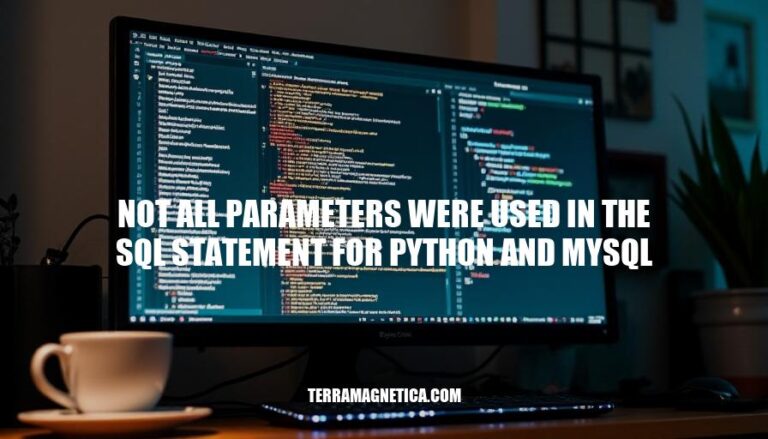


The error “not all parameters were used in the SQL statement” in Python and MySQL typically occurs when there’s a mismatch between the placeholders in the SQL query and the actual parameters provided. This issue is common in database operations and can lead to failed queries, making it crucial for developers to ensure that all parameters are correctly matched to their placeholders.
Here are the common causes of the error “not all parameters were used in the SQL statement” in Python and MySQL:
%d instead of %s for string parameters.? instead of %s in MySQL queries.These issues can lead to the error because the SQL statement expects a certain number of parameters, and if they are not correctly matched, the execution fails.
Here’s a detailed example scenario where the error “not all parameters were used in the SQL statement” occurs in Python with MySQL.
You have a MySQL database with a table named users that has columns id, name, and email. You want to insert a new user into this table using Python.
import mysql.connector
# Establishing the connection
conn = mysql.connector.connect(
host="localhost",
user="yourusername",
password="yourpassword",
database="yourdatabase"
)
cursor = conn.cursor()
# Data to be inserted
user_id = 1
user_name = "John Doe"
user_email = "[email protected]"
# Incorrect SQL statement with missing parameter
sql = "INSERT INTO users (id, name, email) VALUES (%s, %s)"
values = (user_id, user_name, user_email)
try:
cursor.execute(sql, values)
conn.commit()
except mysql.connector.Error as err:
print(f"Error: {err}")
cursor.close()
conn.close()
In the above code, the SQL statement has three placeholders (%s), but the values tuple only provides two values. This mismatch causes the error “not all parameters were used in the SQL statement”.
import mysql.connector
# Establishing the connection
conn = mysql.connector.connect(
host="localhost",
user="yourusername",
password="yourpassword",
database="yourdatabase"
)
cursor = conn.cursor()
# Data to be inserted
user_id = 1
user_name = "John Doe"
user_email = "[email protected]"
# Correct SQL statement with all parameters
sql = "INSERT INTO users (id, name, email) VALUES (%s, %s, %s)"
values = (user_id, user_name, user_email)
try:
cursor.execute(sql, values)
conn.commit()
except mysql.connector.Error as err:
print(f"Error: {err}")
cursor.close()
conn.close()
In the corrected code, the SQL statement now includes three placeholders (%s), matching the three values provided in the values tuple. This resolves the error and allows the insertion to proceed correctly.
Check Placeholder Usage:
%s for MySQL).cursor.execute("INSERT INTO table_name (column1, column2) VALUES (%s, %s)", (value1, value2)).Verify Parameter Count:
Parameter Alignment:
cursor.execute("INSERT INTO table_name (column1, column2) VALUES (%s, %s)", (value1, value2)).Check Data Types:
Debugging:
These steps should help you resolve the error effectively.
Here are the best practices:
Use Parameterized Queries:
cursor.execute("INSERT INTO table_name (column1, column2) VALUES (%s, %s)", (value1, value2))
Correct Placeholder Syntax:
%s as the placeholder for all parameter types in mysql.connector.query = "INSERT INTO employees (first_name, last_name, hire_date, gender, birth_date) VALUES (%s, %s, %s, %s, %s)"
Match Number of Placeholders and Parameters:
data = ('John', 'Doe', '2024-09-30', 'M', '1990-01-01')
cursor.execute(query, data)
Avoid Mixing Placeholder Types:
%s with other placeholder types like %d.# Incorrect
query = "INSERT INTO employees (first_name, last_name, hire_date, gender, birth_date) VALUES (%s, %s, %s, %s, %d)"
# Correct
query = "INSERT INTO employees (first_name, last_name, hire_date, gender, birth_date) VALUES (%s, %s, %s, %s, %s)"
Check Data Types:
Following these practices will help you avoid the “not all parameters were used in the SQL statement” error.
It’s essential to handle parameters carefully in SQL statements to resolve this error.
By following these best practices, you can effectively resolve the error and write secure SQL statements.